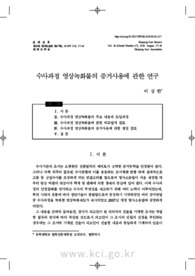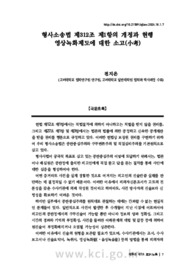

PARTNER
검증된 파트너 제휴사 자료
수사과정 영상녹화물의 증거사용에 관한 연구 (A Study on Using Video Recording of an Investigative Process as Evidence in Trial)
22 페이지
최초등록일 2025.05.04
최종저작일
2019.08

-
미리보기
서지정보
· 발행기관 : 한양법학회
· 수록지 정보 : 한양법학 / 30권 / 3호 / 27 ~ 48페이지
· 저자명 : 이상한
초록
A report drawn up by an investigative agency has been granted strong admissibility of evidence for a long time, as an exception to the hearsay rule. However, this practice led to a focus on confession in investigations and consequent report-oriented trials, thereby fostering coercive investigation; as such, it has been criticized since the enactment of Criminal Procedural Law and has been at the center of academic debates and judicial precedents. Diversified efforts have been made to prevent violation of human rights during investigation and to enhance transparency of investigations, and particularly, backed by technological advancement, video recording of an investigation was recognized as a new evidence, and incorporated into the Criminal Procedural Law revised in 2007.
According to the revised Criminal Procedural Law, video recordings made by an investigative agency can be used either to prove substantial authenticity of investigation reports (Article 312 (2) and (4)) or to evoke memory of a person making a statement at a law court (Article 318-2 (2)). However, even now, a stark controversy surrounds the nature of video recording of an investigation as an evidence: One side claims that such recording should be granted admissibility of evidence on its own, while the other side refutes the idea. To deter report-oriented trial that has been criticized as a persistent problem in criminal trials in Korea and to promote court-oriented trial and examination by the court, it is essential to reduce reliance on investigation reports that hold a dominant position as evidence in criminal trials in Korea. Similarly, video recordings of an investigation need to be utilized restrictively. In this vein, it would be advisable not to acknowledge admissibility of evidence for video recordings of an investigation on its own.영어초록
A report drawn up by an investigative agency has been granted strong admissibility of evidence for a long time, as an exception to the hearsay rule. However, this practice led to a focus on confession in investigations and consequent report-oriented trials, thereby fostering coercive investigation; as such, it has been criticized since the enactment of Criminal Procedural Law and has been at the center of academic debates and judicial precedents. Diversified efforts have been made to prevent violation of human rights during investigation and to enhance transparency of investigations, and particularly, backed by technological advancement, video recording of an investigation was recognized as a new evidence, and incorporated into the Criminal Procedural Law revised in 2007.
According to the revised Criminal Procedural Law, video recordings made by an investigative agency can be used either to prove substantial authenticity of investigation reports (Article 312 (2) and (4)) or to evoke memory of a person making a statement at a law court (Article 318-2 (2)). However, even now, a stark controversy surrounds the nature of video recording of an investigation as an evidence: One side claims that such recording should be granted admissibility of evidence on its own, while the other side refutes the idea. To deter report-oriented trial that has been criticized as a persistent problem in criminal trials in Korea and to promote court-oriented trial and examination by the court, it is essential to reduce reliance on investigation reports that hold a dominant position as evidence in criminal trials in Korea. Similarly, video recordings of an investigation need to be utilized restrictively. In this vein, it would be advisable not to acknowledge admissibility of evidence for video recordings of an investigation on its own.참고자료
· 없음태그
-
자주묻는질문의 답변을 확인해 주세요

꼭 알아주세요
-
자료의 정보 및 내용의 진실성에 대하여 해피캠퍼스는 보증하지 않으며, 해당 정보 및 게시물 저작권과 기타 법적 책임은 자료 등록자에게 있습니다.
자료 및 게시물 내용의 불법적 이용, 무단 전재∙배포는 금지되어 있습니다.
저작권침해, 명예훼손 등 분쟁 요소 발견 시 고객센터의 저작권침해 신고센터를 이용해 주시기 바랍니다. -
해피캠퍼스는 구매자와 판매자 모두가 만족하는 서비스가 되도록 노력하고 있으며, 아래의 4가지 자료환불 조건을 꼭 확인해주시기 바랍니다.
파일오류 중복자료 저작권 없음 설명과 실제 내용 불일치 파일의 다운로드가 제대로 되지 않거나 파일형식에 맞는 프로그램으로 정상 작동하지 않는 경우 다른 자료와 70% 이상 내용이 일치하는 경우 (중복임을 확인할 수 있는 근거 필요함) 인터넷의 다른 사이트, 연구기관, 학교, 서적 등의 자료를 도용한 경우 자료의 설명과 실제 자료의 내용이 일치하지 않는 경우
“한양법학”의 다른 논문도 확인해 보세요!
-
미국의 화학물질관리에서 리스크 평가와 정당화될 수 없는 리스크 25 페이지
In modern society, chemicals are an important benefit to humans, and they can also be disasters. Some of the chemicals do not cause a sudden illness, but some of them slowly and badly influence the ac.. -
不動産投資會社에 있어서 投資者保護에 관한 硏究 24 페이지
The Real Estate Investment Trusts(REITs) is an indirect real estate investment institute that is prescribed in the Real Estate Investment Company Law. The Real Estate Investment Company Law, which gov..
찾으시던 자료가 아닌가요?
지금 보는 자료와 연관되어 있어요!
문서 초안을 생성해주는 EasyAI



